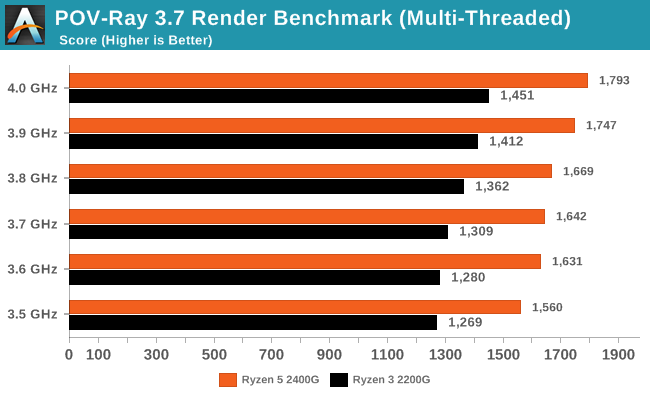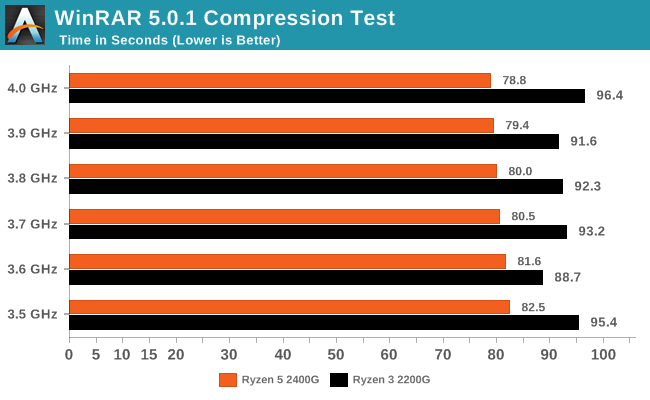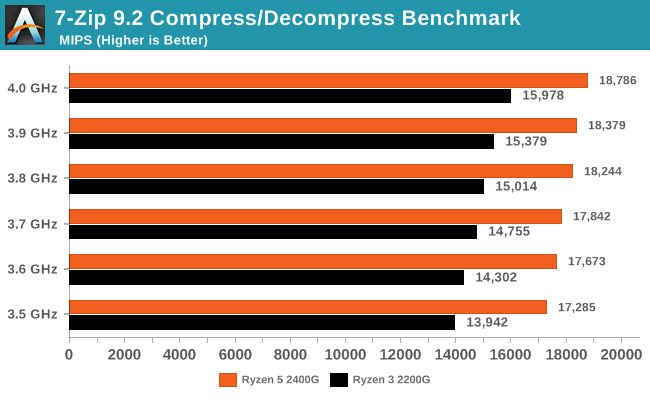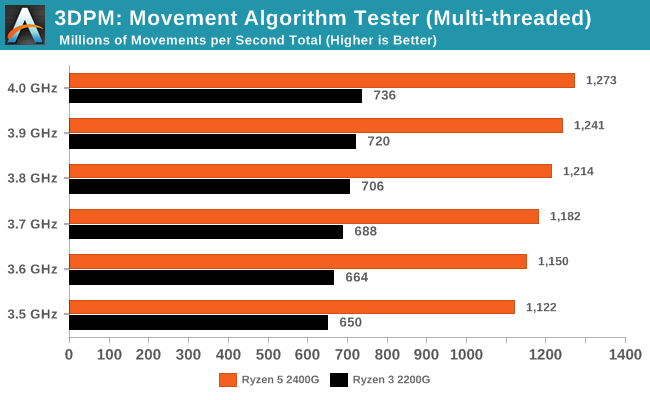AMD Ryzen 5 2400G and Ryzen 3 2200G Core Frequency Scaling: An Analysis
by Gavin Bonshor on June 20, 2018 10:05 AM EST- Posted in
- CPUs
- AMD
- Zen
- APU
- Vega
- Ryzen
- Ryzen 5
- Ryzen 3
- Scaling
- CPU Frequency
- Ryzen 3 2200G
- Ryzen 5 2400G
CPU Performance
As stated on the first page, here we take both APUs from 3.5 GHz to 4.0 GHz in 100 MHz increments and run our testing suite at each stage. This is a 14.3% increase in clock speed, and it is our CPU testing that is likely to show the best linearity in improvement.
Rendering - Blender 2.78: link
For a render that has been around for what seems like ages, Blender is still a highly popular tool. We managed to wrap up a standard workload into the February 5 nightly build of Blender and measure the time it takes to render the first frame of the scene. Being one of the bigger open source tools out there, it means both AMD and Intel work actively to help improve the codebase, for better or for worse on their own/each other's microarchitecture.

The Ryzen 5 2400G scored a +12.1% increase in throughput, while the Ryzen 3 2200G did a bit better at +13.1%.
Rendering – POV-Ray 3.7: link
The Persistence of Vision Ray Tracer, or POV-Ray, is a freeware package for as the name suggests, ray tracing. It is a pure renderer, rather than modeling software, but the latest beta version contains a handy benchmark for stressing all processing threads on a platform. We have been using this test in motherboard reviews to test memory stability at various CPU speeds to good effect – if it passes the test, the IMC in the CPU is stable for a given CPU speed. As a CPU test, it runs for approximately 1-2 minutes on high-end platforms.

The Ryzen 5 2400G gets a +14.9% bump in POV-Ray, compared to the +14.3% we get with the 2200G, which is spot on with the frequency gain.
Compression – WinRAR 5.4: link
Our WinRAR test from 2013 is updated to the latest version of WinRAR at the start of 2014. We compress a set of 2867 files across 320 folders totaling 1.52 GB in size – 95% of these files are small typical website files, and the rest (90% of the size) are small 30-second 720p videos.

For this test, the Ryzen 5 2400G scaled at least in part (+4.7%) across the frequency gain, however the Ryzen 3 2200G was jumping a bit over the place. WinRAR is highly memory sensitive, which is particually why the 2400G only scored a smaller gain, but it would seem that other factors came into play with the 2200G.
Synthetic – 7-Zip 9.2: link
As an open source compression tool, 7-Zip is a popular tool for making sets of files easier to handle and transfer. The software offers up its own benchmark, to which we report the result.

7-zip is another benchmark that can have other bottlenecks, like memory, and as a result we see only a +8.7% gain on the 2400G, however the 2200G gets a full +14.6% gain in performance.
Point Calculations – 3D Movement Algorithm Test: link
3DPM is a self-penned benchmark, taking basic 3D movement algorithms used in Brownian Motion simulations and testing them for speed. High floating point performance, MHz, and IPC win in the single thread version, whereas the multithread version has to handle the threads and loves more cores. For a brief explanation of the platform agnostic coding behind this benchmark, see my forum post here.

3DPM scales very well over cores and threads, being more latency dependent than anything else. The 2400G nets a +13.4% gain in performance up to 4.0 GHz, and the 2200G gets a similar +13.2% gain as well.
Neuron Simulation - DigiCortex v1.20: link
The newest benchmark in our suite is DigiCortex, a simulation of biologically plausible neural network circuits, and simulates activity of neurons and synapses. DigiCortex relies heavily on a mix of DRAM speed and computational throughput, indicating that systems which apply memory profiles properly should benefit and those that play fast and loose with overclocking settings might get some extra speed up. Results are taken during the steady state period in a 32k neuron simulation and represented as a function of the ability to simulate in real time (1.000x equals real-time).

DigiCortex is almost all about the memory performance, although can sometimes be CPU bottlenecked. The 2400G is ultimately hovering around 0.63x-0.65x simulation speed, however the 2200G does see a small gain up to 4% by increasing the core frequency.
HandBrake v1.0.2 H264 and HEVC: link
As mentioned above, video transcoding (both encode and decode) is a hot topic in performance metrics as more and more content is being created. First consideration is the standard in which the video is encoded, which can be lossless or lossy, trade performance for file-size, trade quality for file-size, or all of the above can increase encoding rates to help accelerate decoding rates. Alongside Google's favorite codec, VP9, there are two others that are taking hold: H264, the older codec, is practically everywhere and is designed to be optimized for 1080p video, and HEVC (or H265) that is aimed to provide the same quality as H264 but at a lower file-size (or better quality for the same size). HEVC is important as 4K is streamed over the air, meaning less bits need to be transferred for the same quality content.
Handbrake is a favored tool for transcoding, and so our test regime takes care of three areas.
Low Quality/Resolution H264: Here we transcode a 640x266 H264 rip of a 2 hour film, and change the encoding from Main profile to High profile, using the very-fast preset.

High Quality/Resolution H264: A similar test, but this time we take a ten-minute double 4K (3840x4320) file running at 60 Hz and transcode from Main to High, using the very-fast preset.

HEVC Test: Using the same video in HQ, we change the resolution and codec of the original video from 4K60 in H264 into 4K60 HEVC.











29 Comments
View All Comments
koekkoe - Thursday, June 21, 2018 - link
Improvements beyond 15% are probably anomalies.msroadkill612 - Thursday, June 21, 2018 - link
I kinda wish APU reviewers were less focused on comparisons with the nearest price dgpu PC (garbage no one would actually buy if they went the dgpu route - they would spend hundreds more), and accepted there are many who, having decided on the apu route, sensibly want to do it properly and spend the small premium that takes.For your forthcoming APU memory OC review, IMO, stock cooling on the majority of 2400 ApuS is not real world. Stock is a false economy.
You are getting a ~free (minimalist, but cutting edge vega ecosystem) GPU, and luckily, can better cool both processors with a single improved cooler. $30- $50 doesn't seem too much to budget for decent air cooling. Nor does $220-240 for decent 16GB ram.
The game changing dynamic automatic overclocking that comes with APUs (also on a new process to zen1, which AMD call 14nm+) and Zen+ CPUs, is wonderful, but only as good as the thermal envelope your cooling allows it.
Further, what seems to get overlooked in the fuss about latency trumping clock speed for memory perf, is that mem clock also sets Fabric bus clock speed.
The effects of improving this vital and fundamental zen metric may well go un-noticed by benchmarks for some time, but as the zen/fabric/vega APU ecosystem beds down, Fabric bus speed ~will matter a lot. ~everything must pass through this control point, so its inevitably a bottle neck.
Ratman6161 - Thursday, June 21, 2018 - link
"I kinda wish APU reviewers were less focused on comparisons with the nearest price dgpu PC (garbage no one would actually buy if they went the dgpu route - they would spend hundreds more),"A GTX 1060 is "garbage no one would actually buy"? I'm not into games any more, but back in my younger days I was...and didn't have a lot of money to spend. The graphics aren't really important for my work so I would choose a CPU based on my work requirements and then indulge myself a little on a graphics card that was affordable to me. I used to set a $150 to $200 limit on how much I would spend on graphics and get whatever seemed to be the most bang for the buck in that range. At $230 (cheapest GTX 1060 on New Egg) the 1060 would actually be a bit above my range. Anyway integrated graphics weren't an option then, at least in my situation.
so what if I was a gamer today but didn't have much cash and wanted the best I could get with a small amount of money? Well, Looking at Microcenter which is my go to place for CPU's and motherboards, The 2200G is the cheapest Ryzen CPU available at $80 while the 2400g is $150. In the test results, the 2200g + GTX 1060 performs better than the 2400g with integrated graphics. So in order of price/performance you get (from highest performing to lowest performing):
2400g + 1060 $380
2200G + 1060 $310
2400G + Integrated $150
2200g + integrated $80
If you want the ultimate in cheap, the 2200G is the way to go. If you want something better than the 2400G you could move up to the 2200G + 1060. The 2400 + 1060 combo doesn't make any sense because for the same price I can get an R51600 and add the 1060 to that. Now if it were me (which it isn't :) ), for cheap gaming, i'd probably consider something like a 2200G over clocked as high as I could get it combined with a GTX1050 or similar for $80+$140 = $220. I'd be using the 2200G not for its integrated graphics but because its the cheapest Ryzen I can get right now and its over clockable.
Spunjji - Friday, June 22, 2018 - link
Yeah, I currently have a 1050Ti because it's all I could afford. I game quite a lot. If I had a little more flexibility I'd have pushed to a 1060 and been very happy.Not everyone's highest financial priority is a GPU, even when games are their main source of leisure.
V900 - Friday, September 28, 2018 - link
Nothing wrong with a 1050 or 1060.PC Gamers have just been spoiled by massive performance jumps every generation, and been taught that new=doubleplusgood and old=slowgarbage.
In reality we reached "good enough" a few generations ago.
Heck, look at consoles: I don't see any PS4 gamers complain that their 5 year old GPUs are slow and "garbage".
V900 - Friday, September 28, 2018 - link
Absolutely right! Its been a few years since you could reasonably describe a low end GPU as 'garbage'.If you play games that arent very demanding in terms of graphics (or if youre fine with 30 fps) you can get an Nvidia 1030 for 80-100$
Nothing garbage about that card.
Spend an extra 50$ and you can buy the Nvidia 1050 (130$-150$) and run pretty much any game at 1080p with high settings.
And of course, 100$-200$ can also get you really far if you dont mind a used GPU. Ive seen GTX 970s and 980s in that price range.
boozed - Thursday, June 21, 2018 - link
I just wish an article entitled "An Analysis" included some analysis.V900 - Friday, September 28, 2018 - link
Or if you REALLY want to increase your performance and run 60 fps games at maxed out settings, you could take the 300$ you want to spend on a cooler and "decent" 16GB RAM, and instead get an Nvidia 1050 and 8 GB RAM.And you'll have cash left over for a good game or two.
Nvidia 1030 (or a 750TI) costs less than 100$ on Newegg.
Nvidia 1050 costs around 150$
AntonErtl - Thursday, June 21, 2018 - link
I find the big differences in the CPU results between both APUs at the same clock speed quite surprising. It seems that for some benchmarks SMT (aka Hyperthreading) gives substantial benefits after all. So thanks for the good work and I wish you a speedy recovery.Concerning iGPU overclocking, Computerbase (German) recently had a piece https://www.computerbase.de/2018-06/raven-ridge-ap... on that. One thing worthy of not is that 1350-1450MHz did not work on their iGPUs, but higher overclocks (1500MHz, and, with more voltage, more) worked. Their explanation was that voltage was set too low for the middle frequencies.
dromoxen - Thursday, June 21, 2018 - link
Come what may , these are still budget solutions , adding 16gb of expensive fast ram and best quality Coolers defeats the purpose ... and remember Dgpu are available on the 2nd hand market , esp things like gtx960,970 so adding one doesn't need to break the bank. that's where your upgrade money should go .